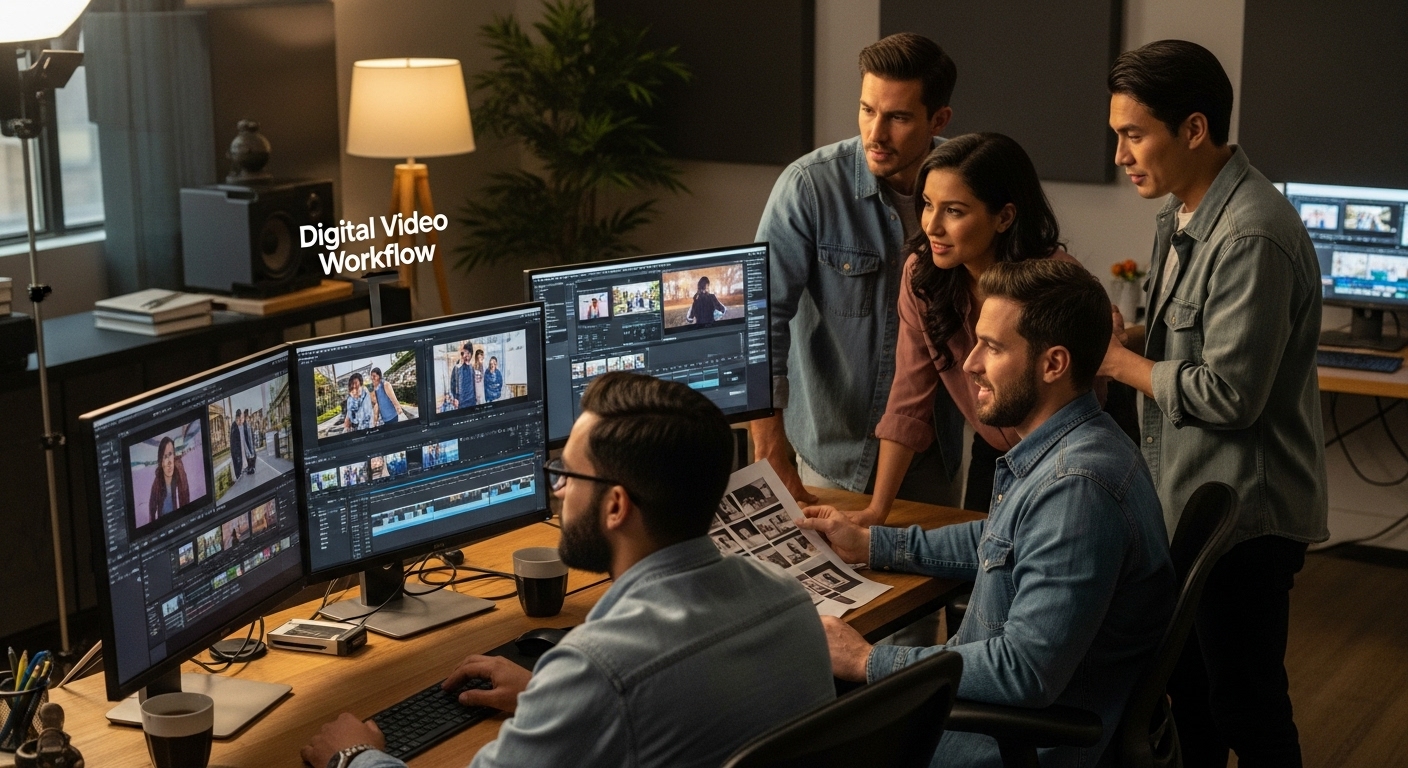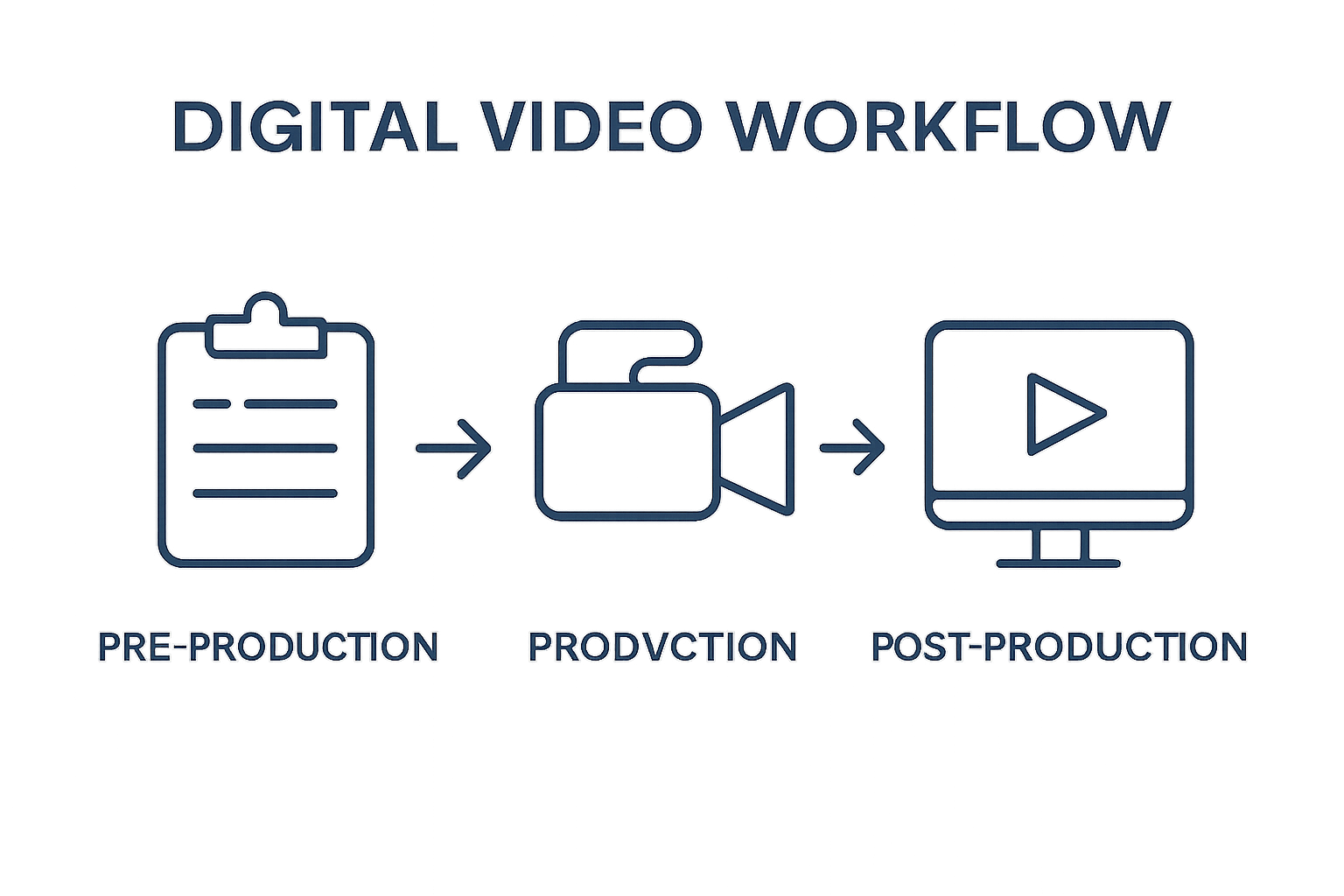Understanding the Digital Video Workflow Process
- info1419758
- Sep 29
- 8 min read

Video production once involved endless wires, bulky equipment, and slow file transfers. Now, with digital workflows, teams manage everything from planning to editing using smart software and cloud tools. It sounds high tech, but here is the surprise. Companies using structured digital workflows see 30 percent fewer production errors and faster project turnarounds. These systems do more than just speed things up—they completely reshape how creative teams turn ideas into compelling video.
Table of Contents
Quick Summary
Takeaway | Explanation |
Establish a structured video workflow. | A structured workflow increases efficiency and minimizes production friction through defined protocols and tools. |
Leverage collaboration tools for production. | Cloud-based platforms enhance real-time communication, improving teamwork and project efficiency during production phases. |
Prioritize pre-production planning. | Thorough pre-production planning ensures a solid foundation through scripting, scheduling, and logistical organization. |
Implement quality control checkpoints. | Standardized quality benchmarks and review processes maintain high creative standards and reduce production errors significantly. |
Stay adaptable to technological advancements. | Embracing emerging technologies can enhance creative possibilities and streamline video production processes. |
Defining Digital Video Workflow: Core Concepts
A digital video workflow represents the comprehensive process of managing, producing, and delivering video content from initial conception through final output. Unlike traditional linear production methods, digital workflows leverage advanced technologies and interconnected systems to streamline every stage of video creation.
What Constitutes a Digital Video Workflow
At its core, a digital video workflow encompasses several critical technological and procedural components that transform raw visual content into polished media. Understanding video workflow software helps professionals comprehend these intricate systems.
Key elements of a robust digital video workflow include:
Ingest and Media Management: Capturing and organizing raw video footage using sophisticated digital asset management platforms
Post Production Processing: Editing, color grading, sound mixing, and visual effects integration
Collaboration Tools: Cloud based platforms enabling real time communication and file sharing among production team members
Technical Infrastructure and Integration
Modern digital video workflows rely on complex technological ecosystems that seamlessly integrate hardware, software, and networking capabilities. These systems must support high resolution file formats, provide efficient data transfer mechanisms, and maintain stringent quality control protocols.
According to Cloudinary’s Video Workflow Research, successful digital video workflows require:
Scalable storage solutions
High performance computing resources
Advanced compression and transcoding technologies
Robust cybersecurity protocols
Strategic Workflow Considerations
Creating an effective digital video workflow demands strategic planning that balances technical capabilities with creative requirements. Professionals must design systems that optimize efficiency while preserving artistic integrity. This involves selecting appropriate software tools, establishing standardized procedures, and continuously adapting to emerging technological innovations.
The ultimate goal of a digital video workflow is not just technical execution but creating a seamless, intelligent ecosystem that empowers creative professionals to transform visual storytelling.
The Importance of a Structured Video Workflow
A structured video workflow transforms chaotic production processes into predictable, efficient systems that maximize creative potential and minimize operational friction. By establishing clear protocols and integrated technological frameworks, professional video creators can significantly enhance project outcomes and reduce potential bottlenecks.
Efficiency and Resource Management
Structured workflows enable precise resource allocation and time management. Professional teams can strategically distribute tasks, track project progress, and identify potential challenges before they escalate. Understanding the stages of video editing provides deeper insights into how systematic approaches optimize creative processes.
Key efficiency benefits include:
Reduced redundant task repetitions
Clear accountability for each production stage
Streamlined communication between team members
Predictable project timelines and deliverable schedules
Quality Control and Consistency
A well-designed workflow establishes standardized quality benchmarks that ensure consistent output across different projects. According to Forrester Research, organizations with structured workflows experience 30% fewer production errors and maintain higher creative standards.
Quality control mechanisms in a structured workflow typically involve:
Comprehensive review checkpoints
Automated technical validation processes
Centralized feedback and revision tracking
Performance benchmarking against predefined metrics
Risk Mitigation and Scalability
Professional video production involves complex technological and creative challenges. A structured workflow acts as a strategic framework that anticipates potential risks, enables rapid problem solving, and creates scalable processes adaptable to evolving project requirements.
By implementing systematic approaches, video production teams transform unpredictable creative endeavors into manageable, repeatable processes that balance artistic innovation with operational excellence.
Key Stages of Digital Video Production
Digital video production is a sophisticated process that transforms creative concepts into compelling visual narratives through carefully orchestrated stages.

Each phase requires specialized skills, technological expertise, and strategic coordination to achieve high quality media outputs.
Pre-Production Planning
The foundation of any successful video project lies in meticulous pre-production planning. This critical initial stage involves conceptualization, scripting, storyboarding, and comprehensive logistical preparation. Understanding video production and post production essentials provides deeper insights into this comprehensive process.
Key pre-production activities include:
Developing narrative concepts and creative briefs
Conducting location scouting and talent casting
Creating detailed production schedules
Securing necessary permits and equipment
Production Execution
Production represents the active filming phase where planned creative strategies are transformed into raw visual content. According to Bureau of Labor Statistics research, this stage demands precise technical skills and collaborative teamwork.
Critical production components encompass:
Capturing high quality video and audio footage
Managing lighting and camera technical specifications
Coordinating talent performance and technical crews
Maintaining consistent visual and narrative quality
Post-Production Refinement
Post-production is where raw footage is meticulously crafted into polished final products through advanced editing, visual effects, sound design, and color grading. This stage synthesizes technical expertise with creative storytelling, converting disparate video elements into cohesive visual experiences.

The ultimate objective of digital video production is not merely technical execution but creating immersive, meaningful visual narratives that effectively communicate intended messages and evoke emotional responses.
To clarify the main stages of digital video production and the activities involved in each, this table summarizes the key steps and focus areas for each phase.
Production Stage | Main Activities | Typical Focus |
Pre-Production Planning | Concept development, scripting, storyboarding, scheduling, permits, equipment prep | Creative direction, logistics |
Production Execution | Video/audio capture, lighting, camera operations, crew and talent management | Technical precision, collaboration |
Post-Production Refinement | Editing, visual effects, sound design, color grading, final output | Storytelling, quality refinement |
Tools and Technologies in Video Workflow
The digital video production landscape is continuously evolving, driven by sophisticated technological ecosystems that enable increasingly complex and efficient creative processes. Advanced tools and technologies have transformed traditional production methodologies, introducing unprecedented levels of precision, collaboration, and creative flexibility.
Software and Digital Platforms
Modern video workflows rely on comprehensive software solutions that integrate multiple production stages. Understanding video production techniques provides deeper insights into how technology shapes creative storytelling.
Key software categories include:
Non linear editing platforms
Cloud based collaboration systems
Asset management and storage solutions
Color grading and visual effects applications
Hardware and Infrastructure
Professional video production demands robust hardware configurations capable of processing high resolution media and supporting complex computational tasks. According to Gartner Research, successful technological infrastructure requires strategic investment in specialized equipment.
Essential hardware components encompass:
High performance workstations
Professional grade cameras and recording equipment
Advanced storage and backup systems
Network infrastructure with high bandwidth capabilities
Emerging Technologies
Cutting edge technologies are continuously reshaping video production workflows. Artificial intelligence, machine learning, and cloud computing are introducing transformative capabilities that streamline traditionally labor intensive processes.
These technological innovations represent more than mere tools they are strategic enablers that empower creative professionals to push the boundaries of visual storytelling, transforming complex production challenges into seamless, efficient experiences.
This table organizes the major categories of tools and technologies used in a modern digital video workflow, highlighting examples and their primary roles within the process.
Category | Example Tools/Technologies | Primary Role in Workflow |
Software & Digital Platforms | Non-linear editors, cloud collaboration, asset management | Integrate and streamline production phases |
Hardware & Infrastructure | Workstations, cameras, storage, high-bandwidth networks | Enable high-quality capture, storage, and editing |
Emerging Technologies | Artificial intelligence, machine learning, cloud computing | Automate and enhance complex production tasks |
Real-World Impact of Effective Video Workflows
Effective digital video workflows transcend technical configurations, delivering tangible business and creative advantages that fundamentally transform how organizations conceptualize, produce, and distribute visual content. These sophisticated systems represent strategic assets that directly influence productivity, quality, and competitive positioning.
Economic and Operational Efficiency
Comprehensive video workflows generate substantial economic benefits by reducing production time, minimizing resource wastage, and optimizing team collaboration. Understanding video production project management software illuminates how strategic technological integration drives operational excellence.
Significant economic advantages include:
Reduced production cycle times
Minimized redundant task performances
Enhanced resource allocation precision
Lower overall production expenditures
Creative and Competitive Advantages
Modern video workflows enable organizations to accelerate innovation and maintain competitive differentiation. According to McKinsey Research, companies with advanced workflow systems demonstrate significantly higher creative output and market responsiveness.
Key competitive benefits encompass:
Faster content iteration cycles
Enhanced cross functional collaboration
Improved creative experimentation capabilities
More consistent brand narrative development
Technological and Strategic Transformation
Video workflows represent more than operational tools they are strategic transformation platforms that reshape how creative teams conceptualize, produce, and distribute visual narratives. By integrating advanced technologies, organizations can transcend traditional production limitations, creating more dynamic, responsive, and innovative content ecosystems.
Ultimately, effective video workflows democratize high quality content production, enabling smaller teams to achieve professional grade results while maintaining unprecedented levels of creative flexibility and technological sophistication.
Tackle Complex Video Workflows with Swiss Expertise
Are you struggling to turn your digital video workflow into a seamless, predictable process? The article highlights how chaotic production stages, permit headaches, crew sourcing, and logistical confusion can derail even the most experienced filmmakers. If you recognize the challenge of coordinating high-quality shoots while keeping your creative vision and technical standards on track, you are not alone. Many professionals find that managing everything from location permits to trusted local crews—especially in a new country—creates stress and roadblocks that slow down every stage of production. For a solution that unites workflow clarity with real-world execution, you need a team that has already solved these problems for international video projects just like yours.

Let Video Production Switzerland take the complexity out of your next shoot. With over 20 years’ experience and deep local knowledge, we offer everything from expert location scouting and reliable crew sourcing to full logistical management and permit handling. Our clear service process, which you can explore here, is designed for clients who want results without surprises. Start with a free consultation today and see how a trusted Swiss partner can help you achieve flawless project delivery—on time and stress-free.
Frequently Asked Questions
What is a digital video workflow?
A digital video workflow is a comprehensive process that manages, produces, and delivers video content from conception to final output, utilizing advanced technologies to streamline each stage of video creation.
What are the key components of a digital video workflow?
Key components include ingest and media management, post-production processing, and collaboration tools that facilitate real-time communication among team members.
How does a structured video workflow enhance efficiency?
A structured video workflow enhances efficiency by reducing redundant tasks, ensuring clear accountability, and enabling streamlined communication, which leads to predictable project timelines.
What technologies are essential for an effective digital video workflow?
Essential technologies for an effective digital video workflow include non-linear editing platforms, cloud-based collaboration systems, high-performance workstations, and advanced storage solutions.
Recommended

Comments